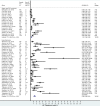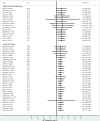Atrial fibrillation detection using single lead portable electrocardiographic monitoring: a systematic review and meta-analysis
- PMID: 30224404
- PMCID: PMC6144487
- DOI: 10.1136/bmjopen-2018-024178
Atrial fibrillation detection using single lead portable electrocardiographic monitoring: a systematic review and meta-analysis
Abstract
Objectives: Recent technology advances have allowed for heart rhythm monitoring using single-lead ECG monitoring devices, which can be used for early diagnosis of atrial fibrillation (AF). We sought to investigate the AF detection rate using portable ECG devices compared with Holter monitoring.
Setting, participants and outcome measures: We searched the Medline, Embase and Scopus databases (conducted on 8 May 2017) using search terms related to AF screening and included studies with adults aged >18 years using portable ECG devices or Holter monitoring for AF detection. We excluded studies using implantable loop recorders and pacemakers. Using a random-effects model we calculated the overall AF detection rate. Meta-regression analysis was performed to explore potential sources for heterogeneity. Quality of reporting was assessed using the tool developed by Downs and Black.
Results: Portable ECG monitoring was used in 18 studies (n=117 436) and Holter monitoring was used in 36 studies (n=8498). The AF detection rate using portable ECG monitoring was 1.7% (95% CI 1.4 to 2.1), with significant heterogeneity between studies (p<0.001). There was a moderate linear relationship between total monitoring time and AF detection rate (r=0.65, p=0.003), and meta-regression identified total monitoring time (p=0.005) and body mass index (p=0.01) as potential contributors to heterogeneity. The detection rate (4.8%, 95% CI 3.6% to 6.0%) in eight studies (n=10 199), which performed multiple ECG recordings was comparable to that with 24 hours Holter (4.6%, 95% CI 3.5% to 5.7%). Intermittent recordings for 19 min total produced similar AF detection to 24 hours Holter monitoring.
Conclusion: Portable ECG devices may offer an efficient screening option for AF compared with 24 hours Holter monitoring.
Prospero registration number: CRD42017061021.
© Author(s) (or their employer(s)) 2018. Re-use permitted under CC BY-NC. No commercial re-use. See rights and permissions. Published by BMJ.
Conflict of interest statement
Competing interests: SR receives equipment and software support from Semacare, a manufacturer of handheld ECG devices. Receives research scholarships from the Heart Foundation and Avant. THM receives equipment and software support from Semacare.
Figures





Similar articles
-
Comparison Between the 24-hour Holter Test and 72-hour Single-Lead Electrocardiogram Monitoring With an Adhesive Patch-Type Device for Atrial Fibrillation Detection: Prospective Cohort Study.J Med Internet Res. 2022 May 9;24(5):e37970. doi: 10.2196/37970. J Med Internet Res. 2022. PMID: 35532989 Free PMC article.
-
Screening for paroxysmal atrial fibrillation in primary care using Holter monitoring and intermittent, ambulatory single-lead electrocardiography.Int J Cardiol. 2021 Dec 15;345:41-46. doi: 10.1016/j.ijcard.2021.10.021. Epub 2021 Oct 21. Int J Cardiol. 2021. PMID: 34687805
-
Dry textile electrode for ambulatory monitoring after catheter ablation of atrial fibrillation: A pilot study of simultaneous comparison to the Holter electrocardiogram.F1000Res. 2022 Jan 26;11:97. doi: 10.12688/f1000research.75712.2. eCollection 2022. F1000Res. 2022. PMID: 35860478 Free PMC article.
-
Lead-I ECG for detecting atrial fibrillation in patients attending primary care with an irregular pulse using single-time point testing: A systematic review and economic evaluation.PLoS One. 2019 Dec 23;14(12):e0226671. doi: 10.1371/journal.pone.0226671. eCollection 2019. PLoS One. 2019. PMID: 31869370 Free PMC article.
-
Cost-Effectiveness of Extended Electrocardiogram Monitoring for Atrial Fibrillation After Stroke: A Systematic Review.Stroke. 2020 Jul;51(7):2244-2248. doi: 10.1161/STROKEAHA.120.029340. Epub 2020 Jun 5. Stroke. 2020. PMID: 32498661
Cited by
-
Comparison of Novel Telemonitoring System Using the Single-lead Electrocardiogram Patch With Conventional Telemetry System.Korean Circ J. 2024 Mar;54(3):140-153. doi: 10.4070/kcj.2023.0252. Korean Circ J. 2024. PMID: 38506104 Free PMC article.
-
Comparison Between the 24-hour Holter Test and 72-hour Single-Lead Electrocardiogram Monitoring With an Adhesive Patch-Type Device for Atrial Fibrillation Detection: Prospective Cohort Study.J Med Internet Res. 2022 May 9;24(5):e37970. doi: 10.2196/37970. J Med Internet Res. 2022. PMID: 35532989 Free PMC article.
-
Heart Rate Variability and Clinical Features as Predictors of Atrial Fibrillation Recurrence After Catheter Ablation: A Pilot Study.Front Physiol. 2021 May 25;12:672896. doi: 10.3389/fphys.2021.672896. eCollection 2021. Front Physiol. 2021. PMID: 34113264 Free PMC article.
-
Validation of Adhesive Single-Lead ECG Device Compared with Holter Monitoring among Non-Atrial Fibrillation Patients.Sensors (Basel). 2021 Apr 30;21(9):3122. doi: 10.3390/s21093122. Sensors (Basel). 2021. PMID: 33946269 Free PMC article.
-
Pharmacy-Based Opportunistic Atrial Fibrillation Screening at a Community Level: A Real-Life Study.Healthcare (Basel). 2022 Jan 4;10(1):90. doi: 10.3390/healthcare10010090. Healthcare (Basel). 2022. PMID: 35052253 Free PMC article.
References
Publication types
MeSH terms
LinkOut - more resources
Full Text Sources
Other Literature Sources
Medical
